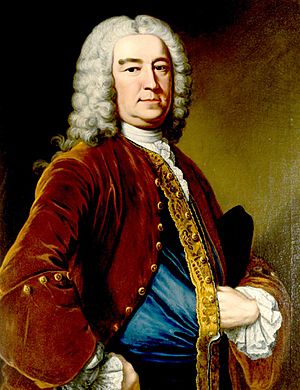Secretary at War facts for kids

Imagine a job in the old English and British government that helped run the army! This was the Secretary at War. This person was in charge of the everyday tasks and organization of the army, like making sure soldiers had what they needed. But they didn't decide how the army would fight wars. They worked in a place called the War Office.
Sometimes, after 1794, this job was important enough to be part of the Cabinet (a group of top government advisors). However, it was usually seen as less powerful than the main Secretaries of State. Eventually, in 1854, this job joined with another important role, the Secretary of State for War, and then it was completely stopped in 1863. Many famous people held this job, like Robert Walpole and Lord Palmerston.
Contents
What Was the Secretary at War?
The Secretary at War was a special government job in England, and later in Britain. This role was created to help manage the army. Think of it as a chief administrator for military matters.
Running the Army's Daily Life
The main task of the Secretary at War was to handle the administration of the army. This means they took care of things like:
- Making sure soldiers were paid.
- Organizing supplies and equipment.
- Keeping records of soldiers and regiments.
- Managing the daily operations of the British Army.
They worked out of an office called the War Office. This office was like the army's headquarters for paperwork and organization.
Not a Military Commander
It's important to know that the Secretary at War was not in charge of military strategy or fighting. They didn't decide where battles would be fought or how troops would move. That was the job of military generals and other high-ranking officials. The Secretary at War focused on the behind-the-scenes work that kept the army running smoothly.
A Job That Changed Over Time
The role of the Secretary at War changed quite a bit over the years.
Early Days (1661-1794)
The position started in 1661. For a long time, it was an important but not top-tier government job. It was mostly about managing the army's finances and daily needs.
Becoming More Important (After 1794)
After 1794, especially during times of war, the Secretary at War sometimes became a Cabinet-level position. This meant the person holding the job was part of the Prime Minister's main group of advisors. Even then, it was usually seen as less powerful than the Secretaries of State, who handled broader government issues.
The End of the Role (1854-1863)
In 1854, during the Crimean War, the government decided to combine the Secretary at War role with a new, more powerful job: the Secretary of State for War. This new position took on more responsibility for military policy and overall control. The old Secretary at War job continued for a short time, but it was finally abolished in 1863. Its duties were fully absorbed into the Secretary of State for War role.
Famous People Who Held the Job
Many well-known figures in British history held the position of Secretary at War. Some of them later became very famous for other reasons.
- Robert Walpole: He later became Britain's first unofficial Prime Minister.
- The Hon. Henry Pelham: He also became a Prime Minister.
- Henry Fox: A prominent politician of his time.
- Lord Palmerston: Another future Prime Minister.
- Lord Macaulay: A famous historian and writer.
These individuals show that even though the Secretary at War wasn't always the most powerful job, it was often a stepping stone for people who would go on to have major impacts on British government and history.
Images for kids


